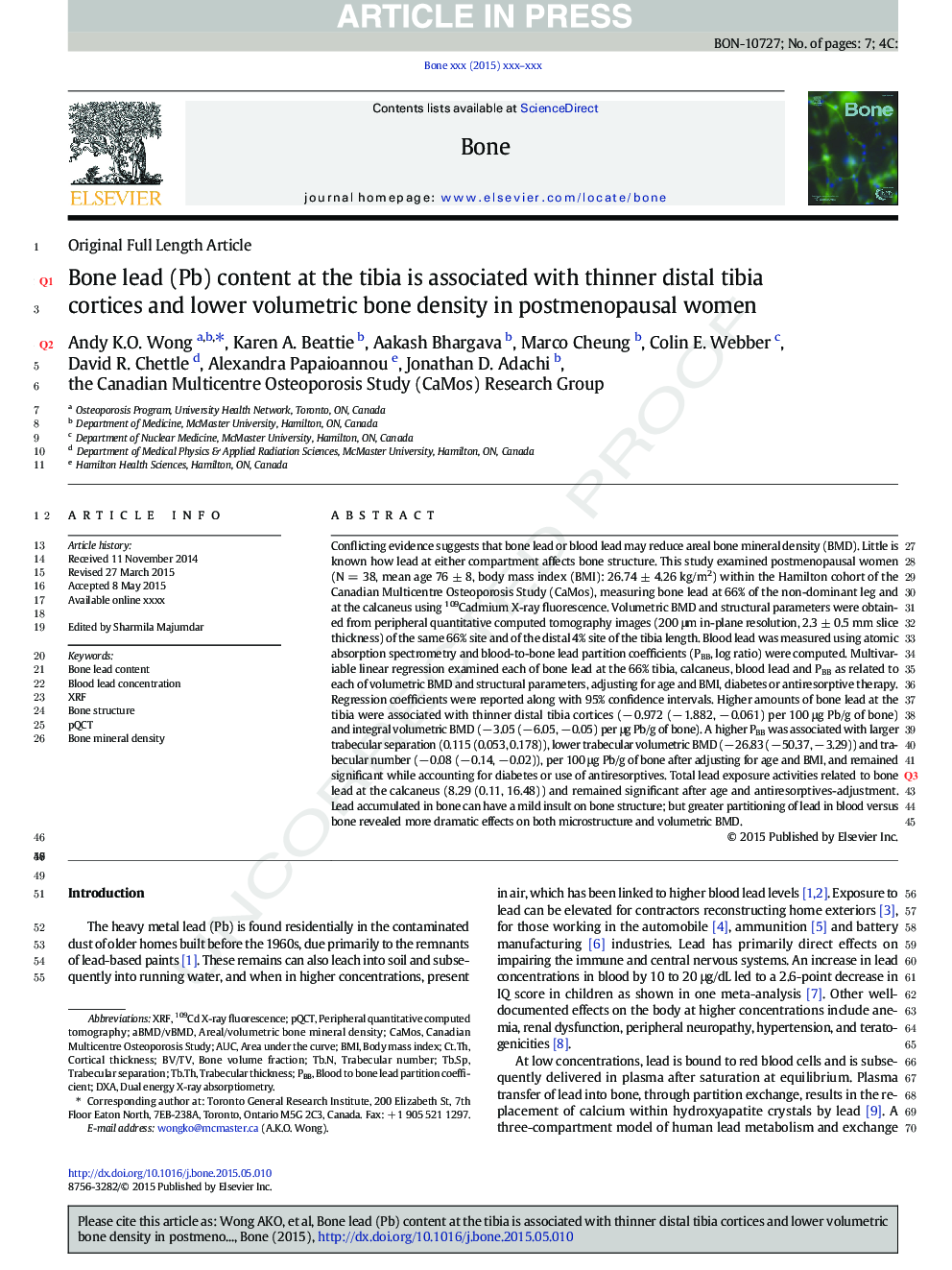| کد مقاله | کد نشریه | سال انتشار | مقاله انگلیسی | نسخه تمام متن |
|---|---|---|---|---|
| 5889472 | 1568140 | 2015 | 7 صفحه PDF | دانلود رایگان |
عنوان انگلیسی مقاله ISI
Bone lead (Pb) content at the tibia is associated with thinner distal tibia cortices and lower volumetric bone density in postmenopausal women
دانلود مقاله + سفارش ترجمه
دانلود مقاله ISI انگلیسی
رایگان برای ایرانیان
کلمات کلیدی
Tb.NTb.SpTb.ThCt.ThpQCTDXAAUC - AUCBV/TV - BV / TVBone mineral density - تراکم معدنی استخوانtrabecular separation - جداسازی ترابکولارdual energy X-ray absorptiometry - جذب سنجی اشعه ایکس انرژی دوگانهBone structure - ساختار استخوانPBB - سازمان ملل متحدbody mass index - شاخص توده بدنBMI - شاخص توده بدنیtrabecular number - شماره تراککالtrabecular thickness - ضخامت تراککالcortical thickness - ضخامت قشرXRF - طیف نگاری فلوئورسانس اشعه ایکسBlood lead concentration - غلظت سرب خونperipheral Quantitative Computed Tomography - محاسبات کمی محاسبات محوریarea under the curve - منطقه تحت منحنیBone volume fraction - کسر حجم استخوان
موضوعات مرتبط
علوم زیستی و بیوفناوری
بیوشیمی، ژنتیک و زیست شناسی مولکولی
زیست شناسی تکاملی
پیش نمایش صفحه اول مقاله

چکیده انگلیسی
Conflicting evidence suggests that bone lead or blood lead may reduce areal bone mineral density (BMD). Little is known about how lead at either compartment affects bone structure. This study examined postmenopausal women (N = 38, mean age 76 ± 8, body mass index (BMI): 26.74 ± 4.26 kg/m2) within the Hamilton cohort of the Canadian Multicentre Osteoporosis Study (CaMos), measuring bone lead at 66% of the non-dominant leg and at the calcaneus using 109Cadmium X-ray fluorescence. Volumetric BMD and structural parameters were obtained from peripheral quantitative computed tomography images (200 μm in-plane resolution, 2.3 ± 0.5 mm slice thickness) of the same 66% site and of the distal 4% site of the tibia length. Blood lead was measured using atomic absorption spectrometry and blood-to-bone lead partition coefficients (PBB, log ratio) were computed. Multivariable linear regression examined each of bone lead at the 66% tibia, calcaneus, blood lead and PBB as related to each of volumetric BMD and structural parameters, adjusting for age and BMI, diabetes or antiresorptive therapy. Regression coefficients were reported along with 95% confidence intervals. Higher amounts of bone lead at the tibia were associated with thinner distal tibia cortices (â 0.972 (â 1.882, â 0.061) per 100 μg Pb/g of bone mineral) and integral volumetric BMD (â 3.05 (â 6.05, â 0.05) per μg Pb/g of bone mineral). A higher PBB was associated with larger trabecular separation (0.115 (0.053, 0.178)), lower trabecular volumetric BMD (â 26.83 (â 50.37, â 3.29)) and trabecular number (â 0.08 (â 0.14, â 0.02)), per 100 μg Pb/g of bone mineral after adjusting for age and BMI, and remained significant while accounting for diabetes or use of antiresorptives. Total lead exposure activities related to bone lead at the calcaneus (8.29 (0.11, 16.48)) and remained significant after age and antiresorptives-adjustment. Lead accumulated in bone can have a mild insult on bone structure; but greater partitioning of lead in blood versus bone revealed more dramatic effects on both microstructure and volumetric BMD.
ناشر
Database: Elsevier - ScienceDirect (ساینس دایرکت)
Journal: Bone - Volume 79, October 2015, Pages 58-64
Journal: Bone - Volume 79, October 2015, Pages 58-64
نویسندگان
Andy K.O. Wong, Karen A. Beattie, Aakash Bhargava, Marco Cheung, Colin E. Webber, David R. Chettle, Alexandra Papaioannou, Jonathan D. Adachi,